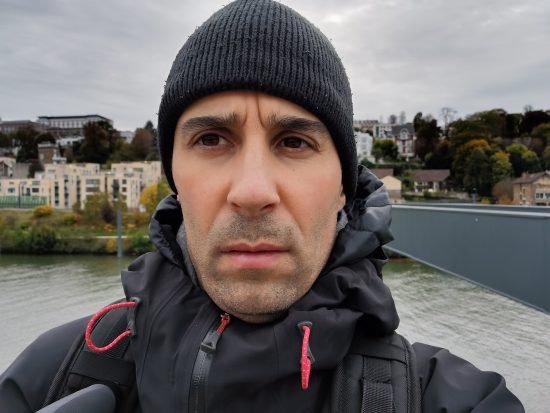The Huawei nova 6 5G is the latest addition to Huawei’s nova line of smartphones that put an emphasis on front camera specifications and performance. Powered by a Kirin 990 chipset, which can also be found in the Mate 30 Pro high-end phone, the nova 6 5G features a dual front camera. The main camera features a 1/2.8-inch 32MP image sensor with a 26mm-equivalent field of view and an f/2.2-aperture lens. It is capable of recording video footage at 4K resolution.
A secondary module is used for both wide-angle selfie capture and depth sensing and creating a simulated bokeh mode. We’ve put the Huawei nova 6 5G front camera through our DXOMARK Selfie front camera test protocol; read on to find out how it performed.
Key front camera specifications:
- Dual front camera
- 1/2.8-inch 32MP sensor with f/2.2 aperture lens, 26mm equivalent
- Secondary wide angle and depth camera
- PDAF
- 2160p at 30 frames per second (4K)
About DXOMARK Selfie tests: For scoring and analysis in our smartphone front camera reviews, DXOMARK engineers capture and evaluate over 1500 test images and more than 2 hours of video both in controlled lab environments and in natural indoor and outdoor scenes, using the camera’s default settings. This article is designed to highlight the most important results of our testing. For more information about the DXOMARK Selfie test protocol, click here.
Test summary


With an overall Selfie score of 100, the Huawei nova 6 5G is the new top-ranked device in the DXOMARK Selfie database. Thanks to a very solid performance across all sub-test categories, it also achieves the best Photo score to date—105—just edging out the Samsung Galaxy Note 10+ 5G by two points.
Still images captured with the nova 6 5G front camera show good exposure in pretty much all conditions, and thanks to HDR processing, have a wide dynamic range, which makes it a good choice for shooting in difficult high-contrast situations. The camera also performs well for color, with nicely rendered skin tones and usually accurate white balance. (We have seen some slight color casts on indoor images, though.) The camera also manages to capture high levels of detail in most conditions while keeping image noise well under control. The nova 6 5G applies a beautification filter which smoothes skin but maintains detail on textured areas, and also preserves unique facial features such as birthmarks and freckles, making for pleasantly natural results.
The camera also comes with an autofocus system that provides good focus from closeup to selfie-stick shooting distances, and the f/2.2-aperture lens offers a wide depth of field, keeping the background and people at the back of group shots in focus as well. In addition, image artifacts are generally well under control, with only some flare and unnatural skin rendering in some images.
The nova 6 5G is also a good choice for selfie shooters who like using flash in low light or use the simulated bokeh mode. The camera increases the display brightness to illuminate the subject and achieves very good results, with good exposure, nice detail, and low levels of noise. Bokeh mode images show decent depth estimation, with only minor errors around the subject, and a smooth gradient blur.
With a Video score of 93, the nova 6 5G is also one of the best-performing devices for front camera video, sharing the top spot in the video ranking with the Note 10+ 5G. The 4K video clips show generally accurate target exposure as well as good detail when recorded in bright light or under typical indoor conditions. Unlike the latest iPhones, the nova does not feature HDR in video mode, though, which can result in some highlight and shadow clipping in harsh lighting. White balance is fairly accurate, and the wide depth of field enhances video footage in the same way as for stills. Performance somewhat drops in low light, however—detail is lost and both chroma and luminance noise become visible.
Photo scores explained
With 105 points, the Huawei nova 6 5G achieves the highest Photo score in our testing to date. We calculate the Photo score from results and analyses of tests that examine different aspects of a device’s still-image performance under different lighting conditions. In this section, we’ll take a closer look at these image quality sub-scores, analyzing some aspects of the Huawei nova 6 5G versus its key competition.

Exposure and Contrast
Huawei nova 6 5G
83
90
The nova 6 5G does well for Exposure. Target exposure on faces is good down to low light, with only occasionally slightly high target exposure on dark skin tones. Thanks to HDR processing, images offer wide dynamic range with good highlight and shadow detail. In the sample below, you can see that the Huawei device preserves more detail in the bright elements of the background than the Asus ZenFone 6 and especially the Samsung Galaxy Note 10+ 5G.

Color
Huawei nova 6 5G
91
100
Color rendering on the nova 6 5G is nice and natural across different skin tones. Color saturation is good and the auto-white balance system produces neutral results in most situations, with a slight yellow/greenish cast only sometimes visible outdoors and a slight greenish cast in indoor images. We have also observed some slight white balance inconsistencies between shots, but they are not any worse than for the competition.

Focus
Huawei nova 6 5G
85
97
Focus is one of the nova 6 5G front camera’s key strengths. A PDAF autofocus system ensures good focus on faces at all subject distances, from a 30cm closeup shot to a 120cm selfie-stick shooting distance.
In addition, the f/2.2 lens aperture provides a wide depth of field, which means a lot of background detail is visible, and makes the Huawei nova 6 5G a good choice for travel selfies in front of tourist sites and similar shots. It also means that people towards the back in group shots are also in focus. To help with that, the nova 6 5G employs a pretty clever focusing strategy for group shots: instead of simply focusing on the nearest face, the camera puts the focus point somewhere between the first and second face. This means the first face is not always tack-sharp, but is still more than acceptably sharp; at the same time, the focus extends towards the back of the group.

Texture
Huawei nova 6 5G
69
85

Noise
Huawei nova 6 5G
80
90
The Huawei nova 6 5G finds a good balance between texture rendering and noise reduction, but is not quite on the same level as the very best in this category. Detail is good when shooting in bright light and under typical indoor conditions, with only some details lost at selfie-stick shooting distances. Noise is very well controlled, too, on faces and background alike, with only some noise slightly visible in the shadow areas of the frame. Some drop-off in detail is noticeable in low light, but the nova still does well against the competition.
It’s also worth noting that the Huawei camera applies a very well-balanced beautification filter that produces very pleasant results. Skin is slightly smoothed, but textured areas such as hair are well preserved, and the system is clever enough to not remove unique facial features such as birthmarks or freckles. Some drop-off is noticeable in low light, but the results are still good relative to many competitors.

Artifacts
Huawei nova 6 5G
83
92
Image artifacts, including those potentially caused by beautification processing, are very well controlled on the Huawei nova 6 5G and don’t have much impact on image quality at all. When shooting in bright light against the sun or another light source, you can see some flare in images, but not any worse than on most other front cameras under similar conditions. If you look quite closely, you’ll also be able to spot some unnatural skin rendering and color quantization on faces, but it’s not intrusive at all.

Flash
Huawei nova 6 5G
89
93
The nova 6 5G briefly cranks up the brightness of its display to illuminate the subject when the flash is activated, and the results are quite pleasant. Target exposure is good both when shooting in total darkness and with 5 lux of tungsten illumination. Detail is good and noise is well under control, too, both on faces and in the image background. However, some light falloff is noticeable towards the edges and a slight green cast is visible in the background of our 0 lux shot below, while the 5 lux image shows a slight pink cast. We also noticed some exposure variations across a series of images when shooting at 0 lux.

Bokeh
Huawei nova 6 5G
70
75
The Huawei nova 6 5G scores well for bokeh, thanks to bokeh simulation images with a smooth blur gradient, and good depth estimation even around difficult areas such as hair. Some depth estimation errors can still be visible, but overall, the Huawei performs very well in this area, making for a pretty natural bokeh effect.
Spotlights in the background usually show good contrast and have a natural shape. Only when shooting in low light did we observe some non-circular spotlights.
Video scores explained
The Huawei nova 6 5G front camera achieves a Video score of 93 points and shares the top spot in our Selfie Video ranking with the Samsung Galaxy Note 10+ 5G, thanks to excellent performance across all areas in its 4K video mode and no real show of weakness. Its Video sub-scores are as follows: Exposure (73), Color (85), Focus (81), Texture (79), Noise (70), Artifacts (84), and Stabilization (79).
When recording video, target exposure is usually spot-on and only slightly low in low light. Unlike some competitors, the nova 6 5G does not feature HDR processing in video mode, though, so some highlight clipping can occur in challenging high-contrast scenes. As with still images, video footage usually shows accurate white balance, but colors tend to be a little dull across all light levels, with relatively low levels of saturation. White balance and exposure adaptation in changing light conditions can be a little slow, too.
The autofocus is stable and generally performs well in video mode. The wide depth of field provides the same benefits as for stills, allowing for good background detail and sharp faces at the back in group selfie videos. Thanks to 4K video resolution, detail is good and noise is well under control in bright light and under indoor lighting. Quality drops off a little in low light, though, with a noticeable loss of detail and the appearance of coarse chroma noise and temporal luminance noise. It’s also worth noting that the nova does not apply a beautification filter in video mode.
Like for stills, artifacts are well under control in nova 6 5G video clips, but flare is occasionally visible and we also saw cyan shift in blue skies. Stabilization works well and effectively counteracts camera shake when walking while recording and while standing still, but some motion blur can be visible at times.
Conclusion
Huawei has always put emphasis on the front camera with its nova series, and the nova 6 5G continues that tradition. Excellent performance in pretty much all test areas secure it the new number one spot in our DXOMARK Selfie ranking, making it an easy recommendation to any ambitious selfie shooter. It’s the best device for Photo that we have tested to date, capturing images with excellent color, exposure, and dynamic range in almost all situations. An effective autofocus system and wide depth of field ensure well-focused subjects and good detail in the background, and the bokeh mode is capable of capturing pleasantly natural results. The camera’s 4K video mode is capable of recording high-quality footage in most situations, making the nova 6 5G a good choice for vloggers and other content creators who shoot selfie videos.
Photo
Pros
- Accurate target exposure
- Nice skin tone rendering
- Good detail in most conditions
- Low levels of image noise
- Good exposure, good detail, and low noise when shooting with flash
Cons
- Occasional yellow/green color cast in bright light and indoors
- Nearest face in some group shots can be very slightly out of focus
- Occasional exposure and white balance instabilities
- Occasional unnatural rendering of skin and local loss of texture
Video
Pros
- Good exposure in bright light and indoors
- Fairly neutral white balance in most conditions
- Good detail in bright light and indoors
- Wide depth of field for group videos
- Effective stabilization
Cons
- Lack of detail in low light
- Chroma and luminance noise visible in low light
- Slightly low exposure in low light
- Slightly limited dynamic range and slow exposure adaptation
- Nearest face can be very slightly out of focus in some group videos

 English
English 中文
中文

































DXOMARK invites our readership (you) to post comments on the articles on this website. Read more about our Comment Policy.